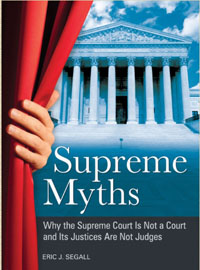Supreme Myths
 March 16, 2012
March 16, 2012
ATLANTA – The Supreme Court of the United States makes important judgments about fundamental questions based on the Justices' ideological preferences, not the law, says Georgia State University College of Law Professor Eric Segall.
Segall will be signing copies of and discussing his new book, Supreme Myths: Why the Supreme Court is not a Court and its Justices are not Judges, on Tuesday, March 20, 4-6 p.m., in the College of Law Library.
In his book, Segall addresses front-page areas of constitutional law such as health care, abortion, affirmative action, gun control, and freedom of religion. He offers a frank description of how the Supreme Court truly operates, a critique of life tenure of its Justices, and a set of proposals aimed at making the Court function more transparently to further the goals of our representative democracy.
While Supreme Court Justices "work in a courtroom, wear black robes, and decide cases brought before them, all that proves is that the Justices look like judges," Segall says. "It does not demonstrate that they decide cases like judges."
How the Justices resolve legal issues, how truthfully they explain their decisions, and what limits (if any) are placed on their authority are the important factors to consider when determining whether the Court functions more like a court of law or more like an ultimate political veto council, he says.
As far as Segall is concerned, the question isn't even close.
"The Supreme Court has never consistently acted like a court, not in 1803, not in the early 1900's not in 2000, not today and not in between," he says.
Contact:
Wendy Cromwell
Director of Communications
404.413.9050